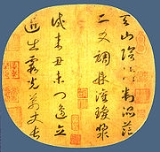
art
in which language
is used for its aesthetic
and evocative qualities in addition to, or in lieu of, its apparent meaning
. Poetry may be written independently, as discrete poems; or, may occur in conjunction with other arts, as in poetic drama, hymn
s, lyrics
, or prose poetry
. It is published in dedicated magazines (the longest established being Poetry
and Oxford Poetry
).
Poetry has a long history
, dating back to the Sumerian
Epic of Gilgamesh
.
Always be a poet, even in prose.![]()
A poet should leave traces of his passage, not proofs. Traces alone engender dreams.![]()
Poets and anarchists are always the first to go. Where. To the frontline. Wherever it is.![]()
An undevout poet is an impossibility.![]()
If you examine the highest poetry in the light of common sense, you can only say that it is rubbish; and in actual fact you cannot so examine it at all, because there is something in poetry which is not in the words themselves, which is not in the images suggested by the words 'O windy star blown sideways up the sky!' True poetry is itself a magic spell which is a key to the ineffable.![]()
I'm a poetry–skipper myself. I don't like to boast, but I have probably skipped more poetry than any other person of my age and weight in this country — make it any other two persons. This doesn't mean that I hate poetry. I don't feel that strongly about it. It only means that those who wish to communicate with me by means of the written word must do so in prose.![]()
You don't have to write anything down to be a poet. Some work in gas stations. Some shine shoes. I don't really call myself one because I don't like the word. Me? I'm a trapeze artist.![]()
It is a test (a positive test, I do not assert that it is always valid negatively), that genuine poetry can communicate before it is understood.![]()

